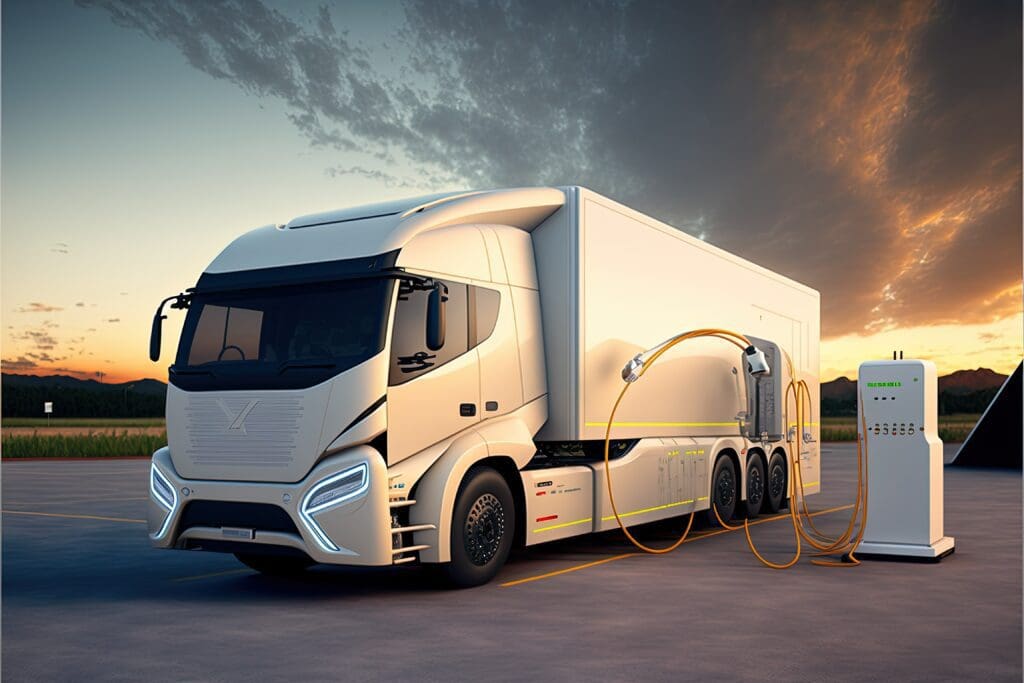- Ryder recently ordered 1,000 Chanje electric vehicles for FedEx. Frito-Lay announced they planned to buy 100 Tesla trucks, and Albertson’s said it will purchase 10 Tesla all-electric Semi tractors for its Southern California stores.
- Canada’s Lion Electric Company, which already has 200 electric school buses running in North America, announced that Constar Supply and C&S Wholesale will be the first U.S. fleets to use the new Lion8 heavy-duty trucks, to be delivered this fall.
- The California Air Resources Board preliminarily awarded $44.8 million to the South Coast Air Quality Management District to fund the Volvo Low Impact Green Heavy Transport Solutions (Volvo LIGHTS). The project aims to develop an “end-to-end” electrification system, and will deploy 23 Class 8 Volvo battery-electric trucks and 24 zero-emission forklifts, along with 58 heavy-duty fast chargers and other related equipment.
- Daimler Trucks North America (DTNA), which boasts the “broadest portfolio of fully-electric commercial vehicles to be found anywhere,” will have nearly 50 electric trucks on U.S. highways this year, bringing its worldwide total to 2,000.
Could this be a critical turning point in transportation history—the “beginning of the post-internal combustion engine era for commercial vehicles” as DTNA president and CEO Roger Nielsen said? So quickly? As certifiedreporter Neil Abt remarked in an article for fleetowner.com, “To see the conversation surrounding electric commercial vehicles advance so far, so fast is quite remarkable. It was only September 2016 when electrification truly had its initial coming out party (at the IAA Commercial Vehicles show in Germany).”
Why Now?
Electric trucks may be advancing so quickly because the technology has improved so much. The cell phone industry has put money and brains behind battery technology and it’s paid off: Advances in battery technology have reduced the cost of vehicle storage batteries by 80% and improved energy density by nearly 50%—and that’s just since 2010.
Another clue can be found in the official name for these trucks: ZE, or zero emissions trucks. Both the federal and state governments are funding efforts to reduce the emissions created by diesel fuel engine. For example, the Environmental Protection Agency (EPA)’s SmartWay program is a “market-driven initiative that empowers businesses to move freight in the cleanest, most energy-efficient way possible. It provides shippers and carriers with the tools and support they need to track, document, and share information about transport modes, equipment, and operational strategies that can reduce fuel use and emissions across the supply chain.” The program appears to be working: its website boasts that it has helped U.S. trucking companies save $33.4 billion on fuel costs. As of this writing SmartWay has 254 transportation industry affiliates and 3722 partners, including Albertson’s, whose Tesla purchase is part of the company’s commitment to the program.
States are encouraging transportation providers to think green, too. California’s Volvo LIGHTS project is one example of a “carrot” project, but there are also some “sticks, ” like the state’s cap-and-trade plan, which puts a cost on emitting carbon into the atmosphere. Nine Eastern states are set to follow suit with their own cap-and-trade plan, and Oregon and Washington State legislators are both considering plans, all of them hoping to shift transportation providers toward cleaner solutions.
But What About Charging?
One of the biggest drawbacks to electric vehicles has been the lack of charging infrastructure, an especially sticky situation in regards to long-haul trucking.
A report issued by the North American Council on Freight Efficiency (NACFE) advises that early adopters of ZE trucks rely on a “return-to-base” strategy. It’s already happening. On April 24, Penske Truck Leasing announced that the company had opened the first DC fast-charging stations in the U.S. designed specifically for heavy-duty commercial electric vehicles. Penske has 14 high-speed chargers at four of its Southern California facilities and plans to add at least six more chargers in the near future.
The NACFE report also suggests that fleets partner with local utility companies, who can be sources of information regarding distribution levels, electrical infrastructure, and even potential funding sources. Utility companies may end up providing even more in support: Companies in California, Oregon and Washington are currently studying how to “electrify” all of I-5 with charging stations for medium- and heavy-duty electric trucks. And though that particular large-scale project, if funded, would take years, pieces of the puzzle are already being fit into place: Southern California Edison announced it will soon have commercial truck charging stations that will support 8,000 vehicles at 800 sites.
And technology may once again speed up the process. Both Tesla and Daimler are exploring high-powered charging systems, while Charging Interface Initiative e. V., as (CharIN) is developing a global standard for charging battery powered electric vehicles.
The Future of Trucking
As technology marches forward, the future of trucking looks bright—and very different. ZE trucks and autonomous truck platoons sound incredible today, but may be commonplace ten years from now.
No matter what the future holds, we know that customers will always be looking for excellent customer service. We promise we will always provide that service, along with exceptional heavy equipment transport services and on-time critical freight delivery. At Next Exit, we earn the trust of our clients with efficiency, transparency, and security. In addition, we understand how to handle freight services for unusual, oversized, or overweight shipments and are certified to arrange the shipment of hazardous materials. To learn more about our services, call Next Exit Logistics at 866-624-2661 or contact us via email.




